队列
在计算机科学中, 一个 队列(queue) 是一种特殊类型的抽象数据类型或集合。集合中的实体按顺序保存。 队列基本操作有两种:入队和出队。从队列的后端位置添加实体,称为入队;从队列的前端位置移除实体,称为出队。 队列中元素先进先出 FIFO (first in, first out)的示意。
队列,其实在我们生活中经常遇到,就比如排队,遵循先进先出规则,就是一种队列,只有排在最前面的人出去了,后面的人才能起来。
这就是队列数据结构的一种限制,并没有像链表那样可以自由插入任一节点,但是有队列数据结构同样可以很好处理各种排队应用场景,比如消息、消费队列等。
一个完整的队列应该包含以下几个点:
- 队头,指的是队列最前面一个,出数据的第一个数据元素
- 队尾,指的排在队列最后一个,进数据的最后一个数据元素
- 入队,指的数据元素进入队列的过程
- 出队,指的数据氧元素出队列的过程
按照各种常见的队列更加深入了解一下。
顺序队列
顺序队列是一种我们最常见的队列类型,一般是采用语言本身自带数组的数据类型去实现的,实现步骤如下:
- 初始化一个长度为
n的数组 - 创建两个变量指针
front和rear,其中front用来标识队头,rear用来标识队尾 - 移动
front和rear,进行入队和出队操作,入队,则将rear+1指向新入队列的元素,出队则将front+1往后移动 - 如果
front===rear则代表队列已空,无法完成出队操作 - 如果
rear===n则代表队列已满,无法完成入队操作
具体代码如下:
class Queue {
constructor(n) {
this.max = n;
this.queue = new Array(n);
this.front = 0;
this.rear = 0;
}
enqueue(val) {
if (this.rear === (this.max - 1)) {
return false;
}
this.queue[this.rear] = val;
this.rear+=1;
return this;
}
dequeue(){
if(this.rear === this.front){
return null;
}
const result = this.queue[this.front];
this.queue[this.front] = undefined;
this.front +=1;
return result;
}
clear(){
this.queue = new Array(this.max);
this.front=0;
this.rear=0;
return this;
}
}
循环队列
循环队列是基于顺序队列做的调整,主要是为了能更好利用顺序队列已清空的元素空间,此时队列的结束位置不再是最后一个位置,允许循环指向开头位置,直到所有队列位置都填满。实现步骤,只需要调整顺序队列的入队操作:
- 入队操作,当
rear位置达到队列最大长度时候,将rear重新指向开始位置0 - 当开始位置已被占用,则表示队列已满
具体代码如下:
/**
* 基于顺序队列做循环队列
*/
class Queue {
constructor(n) {
this.max = n;
this.queue = new Array(n);
this.front = 0;
this.rear = 0;
}
enqueue(val) {
// 调整这里,当移动到最后的时候将rear指针重新指向0,重头开始
if (this.rear === (this.max - 1)) {
this.rear = 0;
}
// 如果当前节点不为空,则表示队列已满,否则继续占用空间
if(this.queue[this.rear]!== undefined){
return false;
}
this.queue[this.rear] = val;
this.rear+=1;
return this;
}
dequeue(){
if(this.rear === this.front){
return null;
}
const result = this.queue[this.front];
this.queue[this.front] = undefined;
this.front +=1;
return result;
}
clear(){
this.queue = new Array(this.max);
this.front=0;
this.rear=0;
return this;
}
}
链式队列
链式队列与顺序队列是一样的,但是底层是采用链表数据结构去实现,实现步骤如下:
- 声明一个空的
链表节点作为front,同时rear节点的指向空的链表 - 入队操作,新建一个链表节点
node,先将rear.next指向新的链表节点node,然后将rear=node - 出队操作,先将
front.next取出,然后再将front.next指向front.next.next即可 - 如果
front.next为空,则无法完成出队操作,表示队列为空 - 因为是链表结构,可以无限添加节点且不占用任何空间,如果要限制队列大小,可以在入队的时候增加链表长度限制
具体代码如下:
import LinkNode from './linklist1.js';
/**
* 假设已有链表结构为LinkNode = ()=>{
* val =
* next =
* }
*/
class Queue {
constructor() {
this.front = new LinkNode();
this.rear = this.front;
}
enqueue(val) {
const prev = this.rear;
const node = new LinkNode(val);
prev.next = node;
this.rear = node;
return this;
}
dequeue(){
if(this.front.next === null){
return null;
}
const result = this.front.next;
result.next = null;
this.front.next = this.front.next.next;
return result.val;
}
clear(){
this.front = new LinkNode();
this.rear = this.front;
return this;
}
}
优先队列
优先队列(priority Queue)是一种特殊的队列,不遵守先进先出的原则,它是按照优先级出队列的。分为最大优先队列(是指最大的元素优先出队)和最小优先队列(是指最小的元素优先出队)。实现步骤如下:
一般用堆数据结构来实现优先队列,在后面讲堆的文章里我会详细再讲,这里了解一下即可。
额外话题
问题:JavaScript中 数组 Array到底算不算一种队列?
答案:JavaScript中的数组是属于队列的一种, 因为数组本身就是支持队列几种特性,对头,队尾,支持入队push,出队unshift,按照队列定义数组应该是属于队列。
但是由于数组在底层上是属于顺序表,内存地址必须是连续的,因此在入队和出队所需的时间复杂度是成线性,大量需要入队出队操作不建议使用数组作为队列使用。
对比一下,链表也是属于线性表的一种,但是它支持内存地址不需要连续的,因此有中对列类型叫链表队列,可以很好解决大量入队出队操作的场景。
